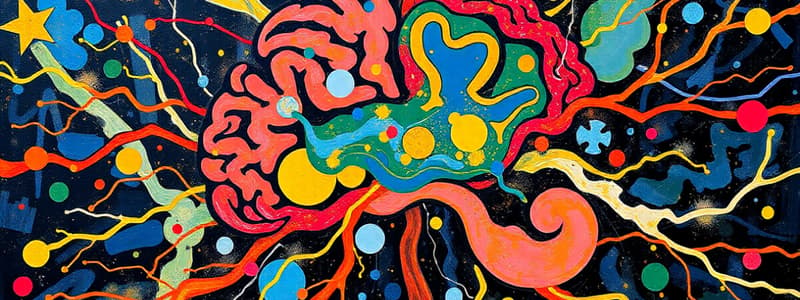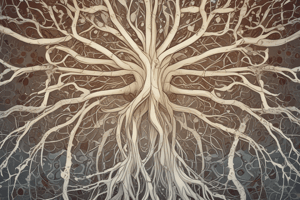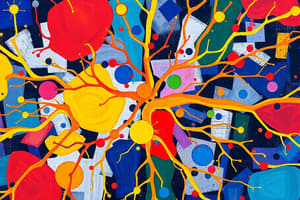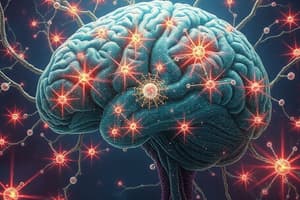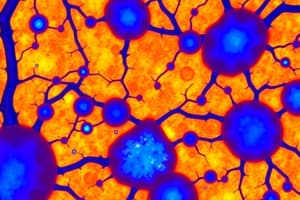Podcast
Questions and Answers
Considering Ramón y Cajal's contributions, which counterfactual scenario would most significantly impede the advancement of modern neuroscience, assuming all other factors remain constant?
Considering Ramón y Cajal's contributions, which counterfactual scenario would most significantly impede the advancement of modern neuroscience, assuming all other factors remain constant?
- If advancements in optical lens technology and staining techniques had been delayed by two decades, thus limiting the resolution and clarity of microscopic observations.
- If Ramón y Cajal had been appointed to a prestigious research institution earlier in his career, diverting his focus from independent investigation and methodological refinement.
- If Ramón y Cajal's father had successfully dissuaded him from pursuing medical studies, leading him to dedicate his life to artistic endeavors exclusively.
- If Camillo Golgi had never developed or shared his tissue-staining method, thereby depriving Cajal of the critical tool that enabled his groundbreaking research. (correct)
Suppose a contemporary research team aims to comprehensively validate Ramón y Cajal's neuron doctrine using advanced optogenetic and connectomic techniques; which methodological pitfall would most critically undermine the integrity of their validation efforts?
Suppose a contemporary research team aims to comprehensively validate Ramón y Cajal's neuron doctrine using advanced optogenetic and connectomic techniques; which methodological pitfall would most critically undermine the integrity of their validation efforts?
- Inadequate consideration of the dynamic plasticity of neural circuits, leading to misinterpretation of static anatomical snapshots. (correct)
- Over-reliance on automated image analysis algorithms without sufficient manual validation of neuronal morphology and connectivity.
- Insufficient replication of experimental findings across multiple brain regions and species, limiting the generalizability of the conclusions.
- Failure to account for the potential neurotoxic effects of prolonged optogenetic stimulation on neuronal function and viability.
Given Ramón y Cajal's meticulous approach to microscopy and anatomical drawing, which statement most accurately encapsulates the epistemological tension inherent in his methodology, considering the limitations of early microscopic techniques?
Given Ramón y Cajal's meticulous approach to microscopy and anatomical drawing, which statement most accurately encapsulates the epistemological tension inherent in his methodology, considering the limitations of early microscopic techniques?
- The inherent limitations of optical resolution at the time constrained his ability to fully resolve the intricacies of synaptic connections. (correct)
- His artistic training, while enhancing his representational skills, may have inadvertently led to idealized depictions of neural structures.
- His reliance on subjective interpretation of visual data introduced biases that compromised the objectivity of his anatomical descriptions.
- The use of Golgi's stain, while revolutionary, introduced artifacts that distorted the true morphology of neuronal elements.
If Ramón y Cajal were to evaluate modern advancements in electron microscopy and computational neuroscience, which aspect would he likely find most compelling regarding its potential to refine our understanding of neural circuitry?
If Ramón y Cajal were to evaluate modern advancements in electron microscopy and computational neuroscience, which aspect would he likely find most compelling regarding its potential to refine our understanding of neural circuitry?
Considering Ramón y Cajal's initial skepticism towards the prevailing reticular theory, which experimental result, if obtained during his time, would have most decisively challenged his neuron doctrine and potentially altered the course of neuroscience?
Considering Ramón y Cajal's initial skepticism towards the prevailing reticular theory, which experimental result, if obtained during his time, would have most decisively challenged his neuron doctrine and potentially altered the course of neuroscience?
Flashcards
Nervous System Organization
Nervous System Organization
Independent cells that communicate with each other to make up the nervous system.
Tissue-Staining Method
Tissue-Staining Method
A technique used to make individual cells more visible under a microscope involving applying stains to tissue samples.
Golgi's Method Modification
Golgi's Method Modification
Santiago Ramón y Cajal modified this method which allowed him to illuminate human brain tissue and further his research.
Histology
Histology
Signup and view all the flashcards
Cajal's Major Book
Cajal's Major Book
Signup and view all the flashcards
Study Notes
Santiago Ramón y Cajal's Neuroscience Contributions
- Santiago Ramón y Cajal, a Nobel laureate, used microscopes to investigate the nervous system's structure.
- He determined that the nervous system consists of independent cells that communicate.
- He was a rebellious child with a passion for drawing, who wanted to be an artist.
- His father, a doctor and anatomy teacher, influenced him to pursue medical school which merged his artistic talents with scientific interests in neuroscience.
- Cajal used his savings to acquire a microscope and began studying muscle tissue structure.
- Cajal's work shifted to histology after receiving a more modern microscope in 1885.
- Optical lens advances and improved staining techniques enhanced microscope capabilities.
- Cajal modified Golgi's tissue staining technique in 1888 to illuminate human brain tissue.
- Cajal showed in 1888 that nerve cells are separate units, disproving the continuous web theory.
- He published the first volume of his book on the nervous system's structure in 1899.
- Cajal and Golgi jointly received the Nobel Prize in 1906 for their work on the nervous system's structure.
- He spent up to 15 hours daily recording observations and produced over 2,900 drawings.
- Spain’s Cajal Institute holds 30,218 "Cajal Legacy" items.
- Golgi's staining method was a career changing moment for Cajal leading him to improve it until it allowed the full visibility of nerve cells.
- Cajal created detailed illustrations of stained cells using his microscope.
- The brain and nervous system comprise billions of individual nerve cells that communicate via synapses.
- Cajal's observations opposed the reticular theory, which claimed nerve fibers were fused.
- In 1891, Wilhelm Waldeyer coined "neuron" and supported the "neuron doctrine" stating that the nervous system's basic units are discrete cells (neurons).
- By the late 19th century, the neuron doctrine replaced reticular theory.
- Electron microscope images in the 1950s confirmed the existence of synapses, supporting the neuron doctrine.
- Cajal and Golgi received the Nobel Prize in 1906 for nervous system studies, yet Golgi still believed nerve cells were physically connected.
- Camillo Golgi invented a tissue-staining technique using silver nitrate in 1873.
- Cajal used pen and ink to reproduce the brain and nervous system's structure with photographic precision.
Max Planck and Quantum Theory
- Max Planck's quantum theory refuted classical physics by stating that energy is emitted in fixed packets, called "quanta."
- Planck altered how scientists interpreted the subatomic world.
- Max Planck showed an aptitude for mechanics, mathematics, and music, and chose to study physics after one tutor sparked his interest.
- He received a doctoral degree at 21.
- In the 1890s, physicists were struggling to explain the absorption and emission of light, specifically "black body" radiation.
- Gustav Kirchhoff in 1859 defined a black body as one that absorbs all electromagnetic radiation.
- When heated, a black body radiates energy in electromagnetic waves, including visible, ultraviolet, and infrared light.
- Classical thermodynamics theories failed to accurately predict wavelengths radiated by hot objects.
- Planck began trying to match theory with observation in 1894.
- From 1885 to 1889, he advanced his study of heat theory.
- He investigated black body radiation and the vibration frequencies of atoms during the 1890s.
- Max Planck presented his radiation distribution law in 1900, introducing energy quanta.
- Planck was one of the first physicists to support Einstein’s Theory of Relativity.
- Planck received the Nobel Prize in Physics in 1919 for discovering energy quanta.
- Planck investigated how the intensity of electromagnetic radiation from a black body depended on the body’s temperature and the frequency of the radiation.
- Physicists believed atoms could oscillate continuously at any frequency.
- Planck noted atoms could only vibrate at frequencies that were whole-number multiples of a base frequency, named "h."
- He calculated the value of h, now called Planck’s constant, with the same numerical value everywhere in the Universe.
- Contrary to classical physics, photons emit energy in measured amounts, or packets, called "quanta."
- A quantum is the smallest possible energy packet.
- Planck's radiation law explained the relationship between an object’s temperature and emitted energy.
- The energy (E) in a photon equals its electromagnetic radiation frequency (v) multiplied by Planck’s constant (h) as expressed in the equation E = hv.
- Planck presented his theory of light as "quantized" energy packets to the German Physical Society in 1900 overturning all past theories of light.
- Planck’s constant (h) allowed scientists to devise a new set of physical units like the Planck length, the smallest unit of measurement possible: 1.6 x 10-3 meters.
- The Planck time is the smallest measurable unit of time: 5 x 10-43 seconds.
- Planck’s theory paved the way for modern technologies like solar power.
- Paul Dirac's Dirac equation predicted antimatter particles, like the positron.
- As a postgraduate student, Dirac created quantum field theory.
Nettie Stevens and Sex Determination
- Nettie Stevens discovered that an animal’s sex is determined by chromosomes.
- Nettie Stevens graduated from Stanford University with a masters in biology in 1900, before earning a doctorate at Bryn Mawr College in 1903.
- Scientists believed biological sex was determined by external factors.
- Stevens's mealworm study ended the debate.
- Male reproductive cells included X and Y chromosomes, but females produced only Xs.
- The sex of an organism is determined by chromosomes it inherits from each parent, published in 1905.
- Her research linked a physical characteristic to a particular chromosome.
- Stevens's discovery was not widely acknowledged until after her death.
- Stevens rejected an offer to be research professor at Bryn Mawr due to ill health and died soon after in 1912.
- Stevens carried out work studying reproductive cells, providing key data to support chromosomal inheritance theory.
George Washington Carver's Agricultural Innovations
- George Washington Carver helped restore the southern US economy through soil improvement and crop cultivation.
- He developed commercially viable products from alternative crops.
- Carver earned a master’s degree in agriculture in 1896 and became the director of agriculture at the Tuskegee Institute.
- The exclusive cotton cultivation had depleted the soil and Carver encouraged farmers to grow peanuts, sweet potatoes, and soybeans instead.
- From 1900 to 1920, Carver invented 287 peanut products and 118 sweet potato products.
- Carver's work created over 400 marketable products, such as oils and dyes, which boosted financial yields of the South.
- He spoke for peanut farmers before the US House of Representatives in 1921 and received a standing ovation.
- He received multiple honors, including the Spingarn Medal in 1923, recognizing outstanding achievement.
- Carver oversaw the Agriculture Department at Tuskegee Institute for 47 years.
Thomas Hunt Morgan and Genetics
- Thomas Hunt Morgan won a Nobel Prize for his work on heredity.
- Following Gregor Mendel's work, Morgan confirmed the role of chromosomes.
- He laid the foundations for the modern field of genetics.
- Morgan was naturally critical, and favored controlled laboratory experiments.
- Fruit flies were ideal specimens because of their traits, small number of chromosomes, and reproduction capabilities.
- Morgan bred millions of fruit flies in his "Fly Room" laboratory.
- All offspring had red eyes, indicating red was dominant when a white-eyed male fly was bred with a red-eyed female.
- A quarter of second-generation offspring had white eyes, and every white-eyed fly was male.
- The white-eyed trait was linked to the fly's sex.
- He concluded traits must be inherited together from the chromosome responsible for sex determination.
- Additional study revealed genes occupy a specific location on a chromosome.
- Morgan confirmed the chromosomal theory of inheritance and acknowledged Mendel’s work.
- Morgan marked a turning point in the study of inheritance and launched the field of genetics by extending Mendel’s work and applying it to animals.
Marie Curie's Radioactivity Research
- Marie Curie discovered polonium and radium and laid the groundwork for radiotherapy.
- Marie Curie studied in secret while working as a governess.
- Curie began research on Becquerel's discovery of radioactivity and Pierre joined her.
- Identified polonium (named after Poland) & radium in uranium ore in 1898.
- The Curies with Becquerel were awarded the 1903 Nobel Prize in Physics.
- Curie took over her husband’s professorship of physics at the Sorbonne.
- She isolated pure radium in 1910.
- She won a second Nobel Prize in 1911 for chemistry.
- Curie coined the term "radioactivity" to describe energy released when atoms disintegrate.
- During World War 1, Curie funded 20 mobile X-ray units and drove one of the trucks herself.
- Curie helped set up the Curie Foundation now the Institut Curie, pioneering cancer treatment research.
- She died of aplastic anemia due to radiation exposure.
- Henri Becquerel was the first to discover natural radioactivity in 1896 with uranium.
Ernest Rutherford and Atomic Structure
- Ernest Rutherford identified the components of the atom and revealed its structure.
- He studied radiation emitted by uranium and discovered types, alpha & beta radiation.
- He proposed that atoms disintegrate and radiation is a by-product of the process.
- He proposed that the rate at which materials disintegrate is their half-lives.
- In 1911, Rutherford published his atom model, likening it to a miniature solar system: empty space, electrons orbiting a tiny nucleus.
- Rutherford became Cavendish Professor of Experimental Physics at Cambridge University in 1919.
- If nitrogen and other light elements are bombarded with alpha particles, they emit hydrogen nuclei.
- Rutherford found the presence of a positive charge in the simplest element, he then named the atom's nucleus a proton.
- The neutron was identified in 1932, by James Chadwick at the Cavendish Laboratory, under Rutherford’s guidance.
António Egas Moniz and Brain Imaging
- António Egas Moniz invented the angiogram and developed the frontal lobotomy.
- Moniz invented X-ray for checking blood vessels, angiogram, in 1927.
- The angiogram technique was used to identify blocked arteries until CT imaging in 1975.
- Moniz was a pioneer in psychosurgery.
- He thought certain mental states, such as obsession and depression, could be eradicated by operating on the frontal lobes: lobotomies (leucotomies).
- A third of patients benefited from surgery, and others experienced serious harm.
- 1949, he received Nobel Prize in Physiology or Medicine for inventing prefrontal lobotomy.
Lise Meitner and Nuclear Fission
- Lise Meitner coined the term "nuclear fission" and explained the science behind splitting uranium atoms.
- 1939, Along with nephew Otto Frisch, publishes theory of nuclear fission in Nature
- Lise Meitner passed an entrance exam and became one of the first women to attend University of Vienna’s physics course.
- A PhD was received in physics after being tutored by Ludwig Boltzmann, becoming the second woman to do so at that university.
- A position as a researcher was taken at Nobel Institute in Stockholm.
- Following the experiment Hanh performed with Uranium, Meitner used information to explain that mass was not lost but converted, creating an enormous amount of energy.
Albert Einstein's Relativity Theories
- Albert Einstein developed the general and special theories of relativity.
- He transformed the concepts of space, time, and gravity.
- His ideas paved the way for nuclear energy and solar power.
- 1905, Wrote four scientific papers bringing attention from academics around the world.
- 1915, While a professor University of Berlin, publishes ‘General Theory of Relativity’
- 1921, Awarded Nobel Prize
- 1933, Emigrates to the US
- 1955, Signs the Russell-Einstein Manifesto
- Made quantum theories, showed Brownian motion, and motion of objects using the speed of light.
- The paper outlined the special theory of relativity, explaining the relative motion of objects moving at constant velocity.
- Time does not run at a single speed.
- 1905, Fourth paper of special relativity
- This paper proved that mass and energy are relative
- This led to the formula: E = mc2
- Used in nuclear power, atomic nuclei are broken apart and loose mass but releasing large amount of energy
- 1915, in the general theory of relativity
- Time slows down in intense gravitational fields, causing time, matter, and light to bend as they pass close to very massive objects.
- Predictions were put to test
- 1919, physicists observing a total solar eclipse, discovered to be out of place
- German physicist S.N. Bose, behaviour of photons-particles of light, send to Einstein, and he published the paper in 1924 - Einstein proposed fifth state of matter, solid,liquid,gas, and plasma- “bosons”
- Scientist made BEC particles in 1995
Alfred Wegener and Continental Drift
- Alfred Wegener proposed the theory of continental drift.
- Wegener's ideas were not accepted until long after his death.
- Wegener received the job meteorologist of Greenland expedition, building the first meteorological station there.
- It was noticed on return from Greenland the continents western Africa and eastern South America mirrored.
- All of Earth continents had once been linked.
- Continents had been separated by the biblical Flood or by land bridges that sunk into the sea.
- Fossils, same spices and rock were searched from the different scientific fields.
- the same ancient rock formations on the African and South American coasts
- 1912, Wegener presented and continents drift.
- Continental drift was the single land mass and was known as “Pangea"
- Wegener made expeditions to Greenland to find more evidence.
- Last Greenland expedidition overexertion death in 1930.
- 16,000km mile, Earth curst tectonic plates , Move
- Mid- Atlantic ridge identified
Marie Tharp
- Geologist and cartographer who charted the ocean floor - her maps identified the mid-Atlantic rift, evidence for the theory of continental drift
- Encouraged to enroll in war due to WWII
- Learned to draw
- 1953, made a discovery of a 9941-mile ridge in the middle of the Atlantic
Dirctory - Scientist
- The linked between science and progress
- New discoveries abonded at rules were rewritten
- 1845-1923.Wilhem Conrad Rontgen- XRAY
- 1849-1936. Ivan Parlou-Military and Medical Academy- Digestive tracks
- 1853-1931-Kitasato Shibasaburo-Serum therapy, tetanus and diphtheria - serum that contained
- Jules Henri Poincore- Chaos
- 1856-1940- JJ Thomson- structure of Atoms, and the plum pudding model
- 1859 - 1927- Svante Arrhenius- Volcanic Irruptions and the green house effect
- Annie Jump cannon- 20th century’s lead authority for spectre
- Harriet Brooks -Canada, 1901, the first female Nuculas
- Ramanujan- invited to Cambridge 1913 (1887-1920)
Francis Crick DNA
- Frederick Sanger who sequenced the components of the three fundamental polymers of life: proteins, RNA, and DNA
- Studied
- 1918( UK doctor and rural practices. - 1936 began self funding - 1943 - 1949 Cavendish - 1953 One of the science greatest mysteries - 1955 - 1972 -1975 -2001 = I has 20 years when
- 1916 - 2004 Nobel Prize biophysicist
James Watson DNA
- US geneticist and biophysicist
- James Watson - the double helix structure of DNA.- genetic code
- Watson moved to California briefly before returning to the Cavendish to work with. -10 days fruit -15 age watston
- Sydney beener - see the Watson and Crick DNA model
Rosalind Franklin - DNA
- 1920 - 1958
- Franklin studied X-ray crystallography
- April 1953 Double hellix with the molecular DNA
Richard freynaman
Feynman
- Is a teacher to quantum theory
- Used showman to communicate -1918-1988, lithuation Jewish -1986 Nasa accident
- Mureay Galinan in 1964 proposed model for particle - Fermions - building blocks - Bosons - forecarriers
- 1920 Henry Stemal- Yalc uni, ,2 more .Woeh
Yang Chen-Ning
- Chinese born theorycal psysists - Revoilized the field. Particle physics -Ground background and atomic - Nobel prize and physic
- 1924 - 2010, Benoit MandelBroth, polish-born French - P hd in math - Fractal gemometry. In 1958. At IMB
Ernest Macholach
- Stem sell research
- Canadian . .Hamelogical
- He recognized to be something new - 1926-2011 -2010. Inducted Canada
- James till 1931 physicist - 1969. Fellowship -2005. Albt Lasker with Mcollach. Mcolla.
Studying That Suits You
Use AI to generate personalized quizzes and flashcards to suit your learning preferences.
Description
Explore counterfactual scenarios impacting neuroscience without Ramón y Cajal. Understand validation pitfalls for neuron doctrine using modern techniques. Examine tensions in Cajal's methods with early microscopy and his view on modern advancements for neural circuitry.
